The Impact of Changes in Green Space Structures on Thermal Mitigation and Costs under a Constant Green Volume
Abstract
:1. Introduction
2. Materials and Methods
2.1. Research Background and Model Information
2.2. Residential Green Space Scenarios Setup and Envi-Met Verification
3. Results
3.1. The Thermal Comfort of Nine Green Space Scenarios
3.2. The Thermal Mitigation and Economics of Nine Scenarios
4. Discussion
4.1. Analysis of Differences in Thermal Mitigation of Green Space Scenarios
4.2. Residential Green Space Structure Proposals Based on Thermal Mitigation and Costs
5. Conclusions
Author Contributions
Funding
Data Availability Statement
Conflicts of Interest
Appendix A
| Instruments | Indicators | Instrument Precision |
|---|---|---|
| JANTYTHCH 2022 | air temperature | 0.1 °C |
| wind speed | 0.1 m/s | |
| black globe temperature | 0.1 °C | |
| Kestrel 5500 | wind direction | 1° |
| wind speed | 0.1 m/s | |
| DS1923 (i-Button) | Ta/RH | 0.1 °C/0.1% |
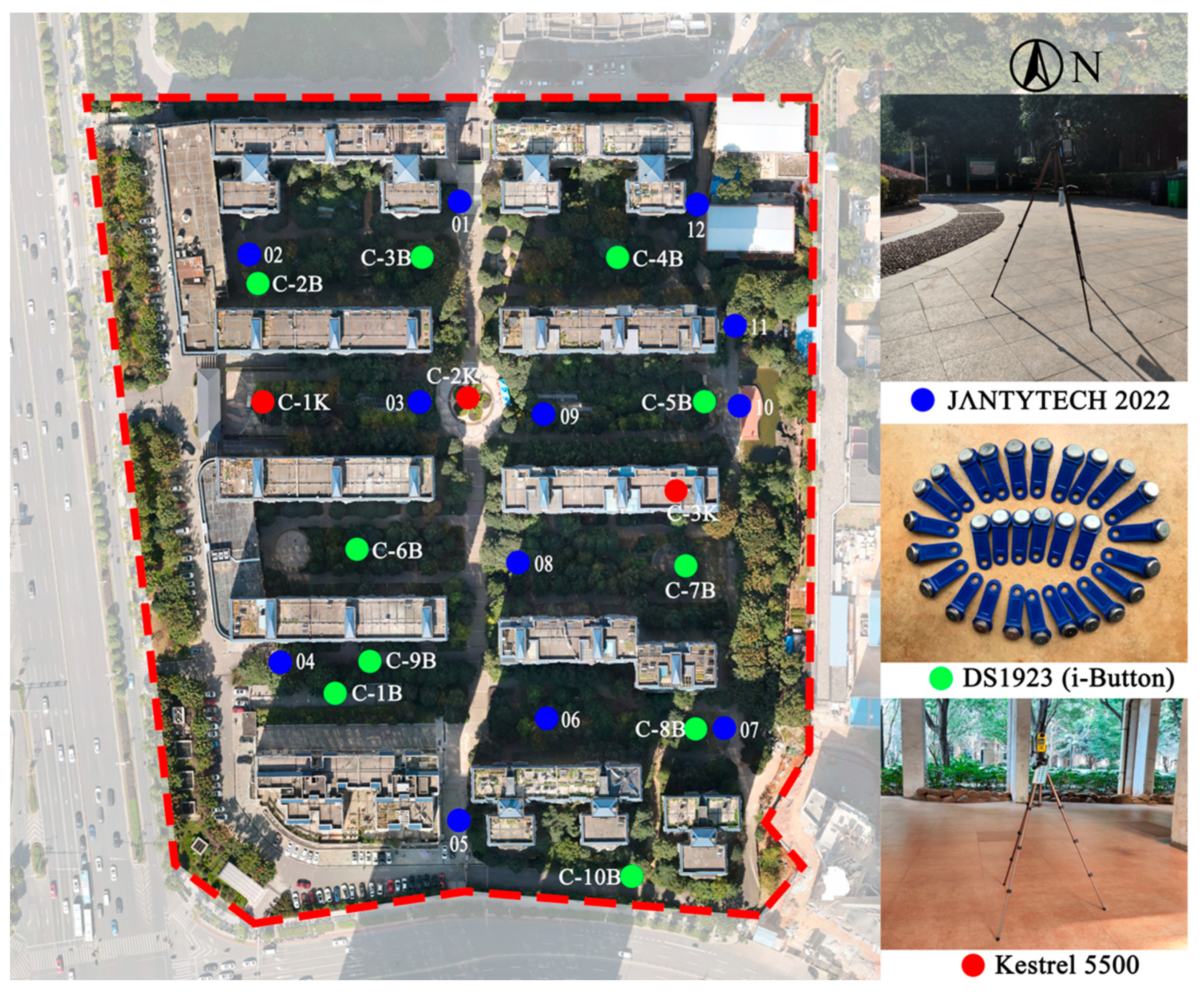
References
- Huang, W.W.; Lin, G.S. The relationship between urban green space and social health of individuals: A scoping review. Urban For. Urban Green. 2023, 85, 127969. [Google Scholar] [CrossRef]
- Qi, J.D.; Lin, E.S.; Tan, P.Y.; Zhang, X.D.; Ho, R.G.; Sia, A.; Olszewska-Guizzo, A.; Waykool, R. Representing the landscape visual quality of residential green spaces in Singapore with 3D spatial metrics. Urban For. Urban Green. 2023, 90, 128132. [Google Scholar] [CrossRef]
- Yang, Y.J.; Zhou, D.; Wang, Y.P.; Meng, X.Z.; Gu, Z.L.; Xu, D.; Han, X.X. Planning method of centralized greening in high-rise residential blocks based on improvement of thermal comfort in summer. Sustain. Cities Soc. 2022, 80, 103802. [Google Scholar] [CrossRef]
- Yuan, Y.F.; Liao, Z.; Zhou, B.Q.; Zhai, P.M. Unprecedented Hot Extremes Observed in City Clusters in China during Summer 2022. J. Meteorol. Res. 2023, 37, 141–148. [Google Scholar] [CrossRef]
- Grilo, F.; Pinho, P.; Aleixo, C.; Catita, C.; Silva, P.; Lopes, N.; Freitas, C.; Santos-Reis, M.; McPhearson, T.; Branquinho, C. Using green to cool the grey: Modelling the cooling effect of green spaces with a high spatial resolution. Sci. Total Environ. 2020, 724, 138182. [Google Scholar] [CrossRef] [PubMed]
- Zhang, D.H.; Xie, X.; Zhou, C.S. Spatial influence of exposure to green spaces on the climate comfort of urban habitats in China. Urban Clim. 2023, 51, 101657. [Google Scholar] [CrossRef]
- Yin, J.; Ramanpong, J.; Chang, J.; Wu, C.D.; Chao, P.H.; Yu, C.P. Effects of blue space exposure in urban and natural environments on psychological and physiological responses: A within-subject experiment. Urban For. Urban Green. 2023, 87, 128066. [Google Scholar] [CrossRef]
- Juul, V.; Nordbo, E.C.A. Examining activity-friendly neighborhoods in the Norwegian context: Green space and walkability in relation to physical activity and the moderating role of perceived safety. BMC Public Health 2023, 23, 259. [Google Scholar] [CrossRef] [PubMed]
- Xia, T.Y.; Zhao, B.; Xian, Z.; Zhang, J.G. How to Systematically Evaluate the Greenspace Exposure of Residential Communities? A 3-D Novel Perspective Using UAV Photogrammetry. Remote Sens. 2023, 15, 1543. [Google Scholar] [CrossRef]
- Gomaa, M.M.; El Menshawy, A.; Nabil, J.; Ragab, A. Investigating the Impact of Various Vegetation Scenarios on Outdoor Thermal Comfort in Low-Density Residential Areas of Hot Arid Regions. Sustainability 2024, 16, 3995. [Google Scholar] [CrossRef]
- Li, J.Y.; Zheng, B.H.; Bedra, K.B. Evaluating the improvements of thermal comfort by different natural elements within courtyards in Singapore. Urban Clim. 2022, 45, 101253. [Google Scholar] [CrossRef]
- Wang, H.H.; Cai, Y.; Deng, W.F.; Li, C.; Dong, Y.; Zhou, L.; Sun, J.Y.; Li, C.; Song, B.Z.; Zhang, F.F.; et al. The Effects of Tree Canopy Structure and Tree Coverage Ratios on Urban Air Temperature Based on ENVI-Met. Forests 2023, 14, 80. [Google Scholar] [CrossRef]
- Zhu, R.R.; Liu, Y.B.; Yan, B.W.; Zhang, X.T.; Yuan, L.Y.; Wang, Y.F.; Pan, Y.T. Effects of district parameters, green space and building density on thermal comfort—A case study of Badaguan District in Qingdao. Case Stud. Therm. Eng. 2023, 42, 102705. [Google Scholar] [CrossRef]
- Mihara, K.; Hii, D.J.C.; Takasuna, H.; Sakata, K. How does green coverage ratio and spaciousness affect self-reported performance and mood? Build. Environ. 2023, 245, 110939. [Google Scholar] [CrossRef]
- Kim, S.W.; Brown, R.D. Pedestrians’ behavior based on outdoor thermal comfort and micro-scale thermal environments, Austin, TX. Sci. Total Environ. 2022, 808, 152143. [Google Scholar] [CrossRef]
- Lin, C.; Yang, J.H.; Huang, J.; Zhong, R.Z. Examining the Effects of Tree Canopy Coverage on Human Thermal Comfort and Heat Dynamics in Courtyards: A Case Study in Hot-Humid Regions. Atmosphere 2023, 14, 1389. [Google Scholar] [CrossRef]
- Zhao, Y.; Yang, J.H.; Fang, Z.S.; Zhang, X.; Guo, T.Y.; Li, Y.K. Passive design strategies to improve student thermal comfort: A field study in semi-outdoor spaces of academic buildings in hot-humid areas. Urban Clim. 2024, 53, 101807. [Google Scholar] [CrossRef]
- Li, Y.N.; Lin, D.L.; Zhang, Y.H.; Song, Z.P.; Sha, X.H.; Zhou, S.Q.; Chen, C.; Yu, Z.W. Quantifying tree canopy coverage threshold of typical residential quarters considering human thermal comfort and heat dynamics under extreme heat. Build. Environ. 2023, 233, 110100. [Google Scholar] [CrossRef]
- Ong, B.L. Green plot ratio: An ecological measure for architecture and urban planning. Landsc. Urban Plan. 2003, 63, 197–211. [Google Scholar] [CrossRef]
- Halecki, W.; Stachura, T.; Fudala, W.; Stec, A.; Kubon, S. Assessment and planning of green spaces in urban parks: A review. Sustain. Cities Soc. 2023, 88, 104280. [Google Scholar] [CrossRef]
- Sichuan Provincial Department of Housing and Urban-Rural Development. Design Standard for Residential Buildings in Sichuan Province; Southwest Jiaotong University Press: Chengdu, China, 2021. [Google Scholar]
- Shenzhen Housing and Construction Bureau. Assessment Standard for Green Building; China Archiecture Publishing: Beijing, China, 2018. [Google Scholar]
- Fujian Provincial Department of Housing and Urban-Rural Development. Assessment Standard for Green Building in Fujian Province; Fujian Provincial Department of Housing and Urban-Rural Development: Fujian, China, 2021. [Google Scholar]
- Zheng, J.; Li, Z.L.; Zheng, B.H. A Study on the Effect of Green Plot Ratio (GPR) on Urban Heat Island Intensity and Outdoor Thermal Comfort in Residential Areas. Forests 2024, 15, 518. [Google Scholar] [CrossRef]
- Liao, J.J.; Tan, X.; Li, J.Y. Evaluating the vertical cooling performances of urban vegetation scenarios in a residential environment. J. Build. Eng. 2021, 39, 102313. [Google Scholar] [CrossRef]
- Atwa, S.; Ibrahim, M.G.; Murata, R. Evaluation of plantation design methodology to improve the human thermal comfort in hot-arid climatic responsive open spaces. Sustain. Cities Soc. 2020, 59, 102198. [Google Scholar] [CrossRef]
- Ličina, V.F.; Cheung, T.; Zhang, H.; De Dear, R.; Parkinson, T.; Arens, E.; Chun, C.; Schiavon, S.; Luo, M.; Brager, G. Development of the ASHRAE global thermal comfort database II. Build. Environ. 2018, 142, 502–512. [Google Scholar] [CrossRef]
- Liu, W.W.; Zhang, Y.X.; Deng, Q.H. The effects of urban microclimate on outdoor thermal sensation and neutral temperature in hot-summer and cold-winter climate. Energy Build. 2016, 128, 190–197. [Google Scholar] [CrossRef]
- Simon, H.; Lindén, J.; Hoffmann, D.; Braun, P.; Bruse, M.; Esper, J. Modeling transpiration and leaf temperature of urban trees—A case study evaluating the microclimate model ENVI-met against measurement data. Landsc. Urban Plan. 2018, 174, 33–40. [Google Scholar] [CrossRef]
- Bruse, M. Die Auswirkungen Kleinskaliger Umweltgestaltung auf das Mikroklima: Entwicklung des Prognostischen Numerischen Modells ENVI-Met zur Simulation der Wind-, Temperatur-und Feuchteverteilung in Städtischen Strukturen; Ruhr-Universität Bochum: Bochum, Germany, 1999. [Google Scholar]
- Ministry of Housing and Urban-Rural Development of the People’s Republic of China. Design Standard for Thermal Environment of Urban Residential Areas; China Archiecture Publishing: Beijing, China, 2013. [Google Scholar]
- Ministry of Housing and Urban-Rural Development of the People’s Republic of China. Standard for Urban Residential Area Planning and Design; China Archiecture Publishing: Beijing, China, 2018. [Google Scholar]
- Matzarakis, A.; Mayer, H.; Iziomon, M.G. Applications of a universal thermal index: Physiological equivalent temperature. Int. J. Biometeorol. 1999, 43, 76–84. [Google Scholar] [CrossRef] [PubMed]
- Heidari, A.; Davtalab, J.; Sargazi, M.A. Effect of awning on thermal comfort adjustment in open urban space using PET and UTCI indexes: A case study of Sistan region in Iran. Sustain. Cities Soc. 2024, 101, 105175. [Google Scholar] [CrossRef]
- Luo, X.Y.; Zhao, Y.; Li, Y.K.; Yang, J.H.; Guo, T.Y. Effects of tree species and planting forms on the thermal comfort of campsites in hot and humid areas of China. Int. J. Biometeorol. 2024, 68, 1437–1449. [Google Scholar] [CrossRef]
- Liu, Z.X.; Brown, R.D.; Zheng, S.L.; Jiang, Y.; Zhao, L.H. An in-depth analysis of the effect of trees on human energy fluxes. Urban For. Urban Green. 2020, 50, 126646. [Google Scholar] [CrossRef]
- Xiao, Q.K.; Fan, X.; Guo, Y.Y.; Li, S.T.; He, W.; Deng, Y.C.; Xiao, Z.Y.; Wang, P.C.; Wu, C.G. Tree form characteristics as criteria for tree species selection to improve pedestrian thermal comfort in street canyons: Case study of a humid subtropical city. Sustain. Cities Soc. 2024, 105, 105339. [Google Scholar] [CrossRef]
- Huang, J.; Kong, F.H.; Yin, H.W.; Middel, A.; Liu, H.Q.; Zheng, X.D.; Wen, Z.H.; Wang, D. Transpirational cooling and physiological responses of trees to heat. Agric. For. Meteorol. 2022, 320, 108940. [Google Scholar] [CrossRef]
- Li, J.Y.; Zheng, B.H.; Ouyang, X.; Chen, X.; Bedra, K.B. Does shrub benefit the thermal comfort at pedestrian height in Singapore? Sustain. Cities Soc. 2021, 75, 103333. [Google Scholar] [CrossRef]
- Sun, B.; Zhang, H.; Zhao, L.; Qu, K.C.; Liu, W.H.; Zhuang, Z.C.; Ye, H.Y. Microclimate Optimization of School Campus Landscape Based on Comfort Assessment. Buildings 2022, 12, 1375. [Google Scholar] [CrossRef]
- Yu, M.; Song, S.Q.; Jiang, C.L.; Ding, K.; Tan, L.; Ma, J.; Li, Y.Y. Multi-objective optimization of plant community characteristics in urban green spaces. Urban For. Urban Green. 2024, 98, 128397. [Google Scholar] [CrossRef]


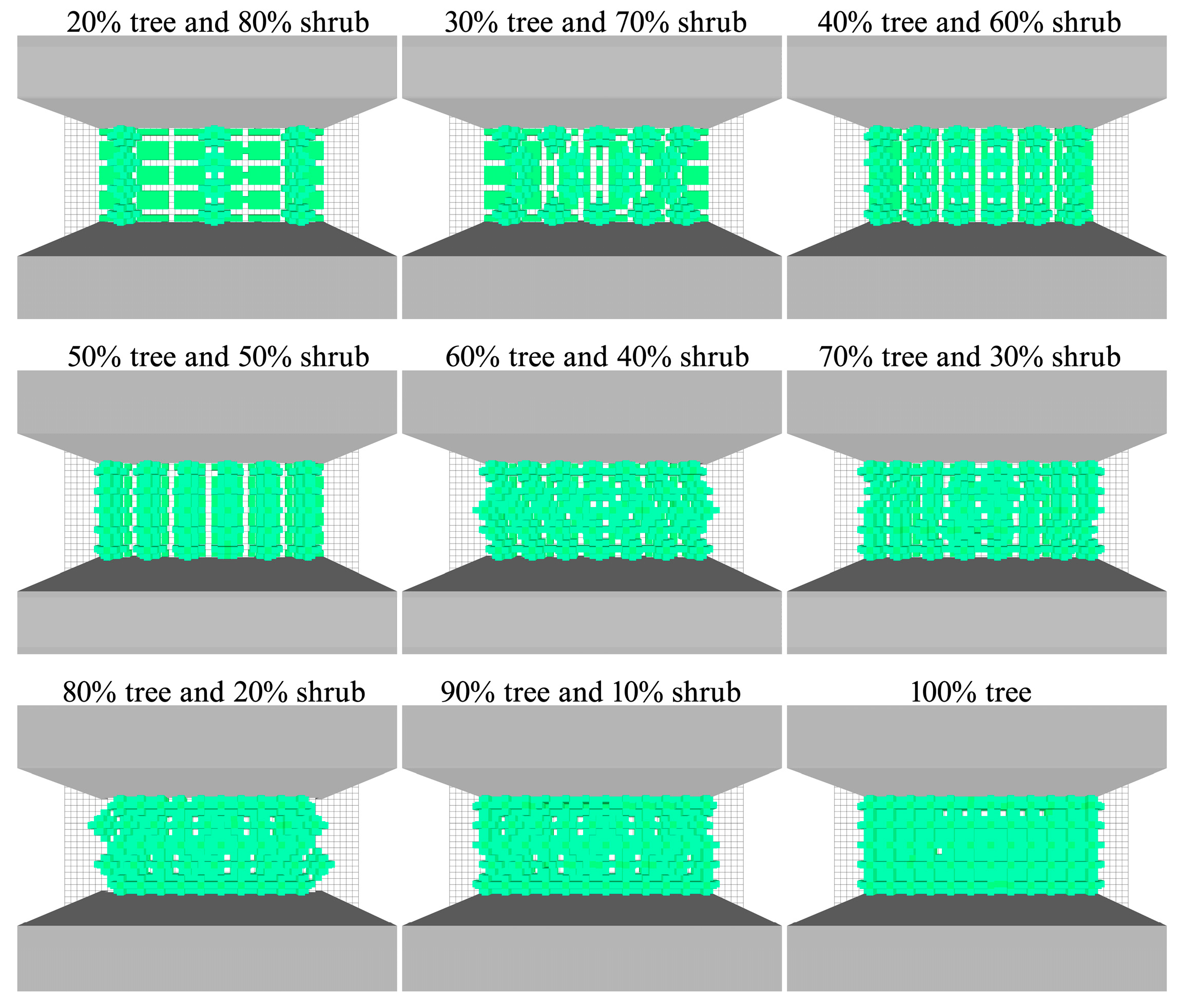

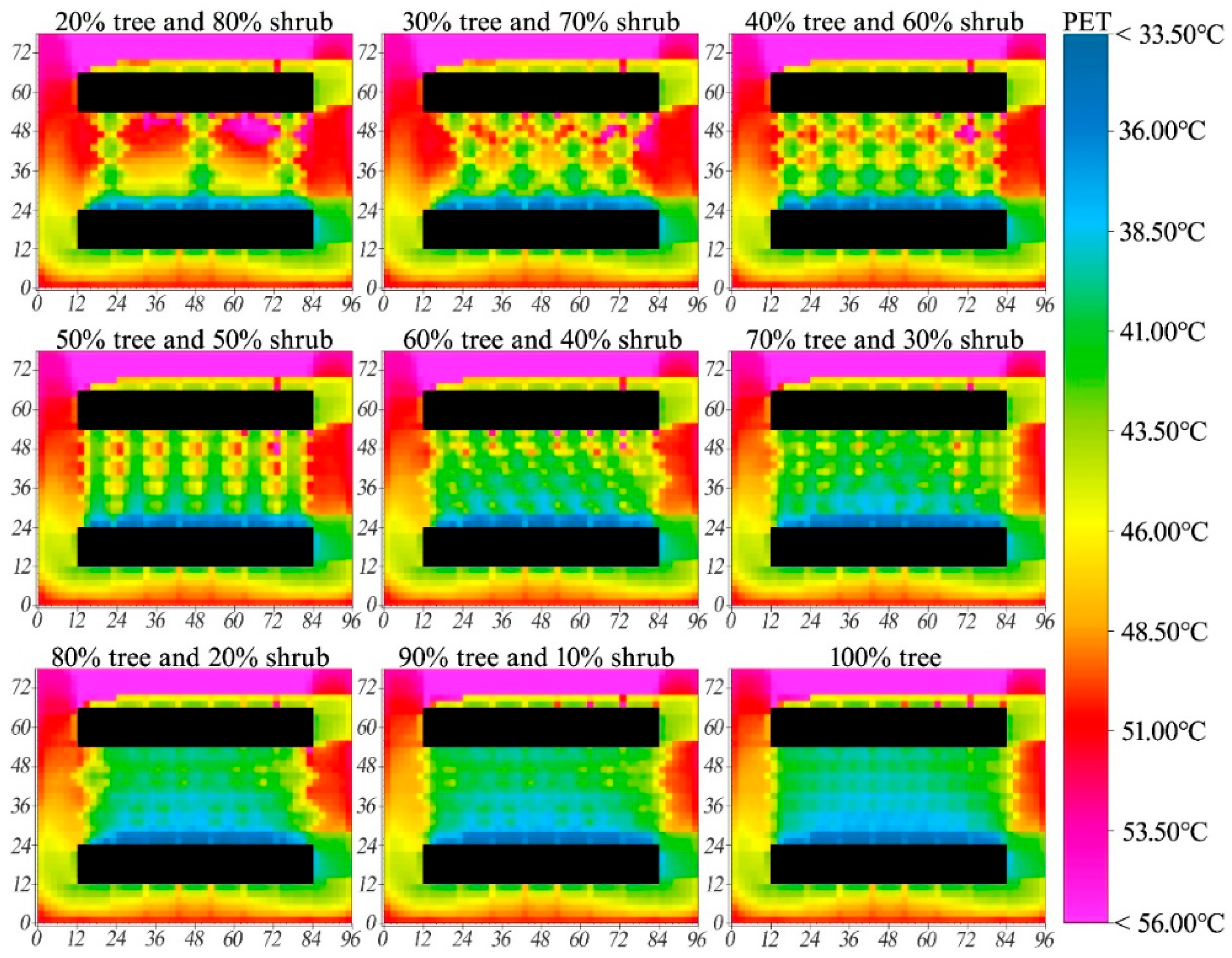
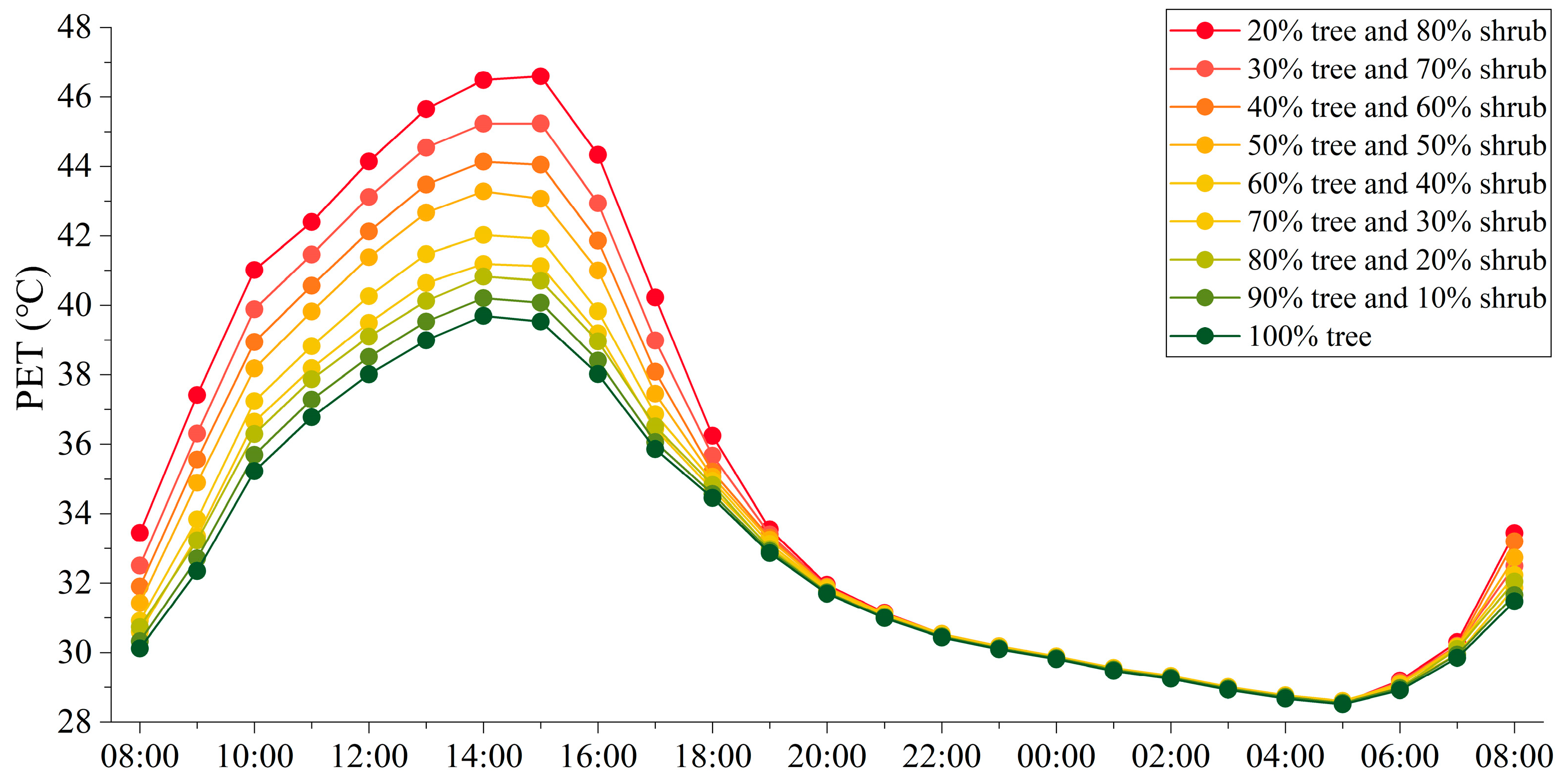
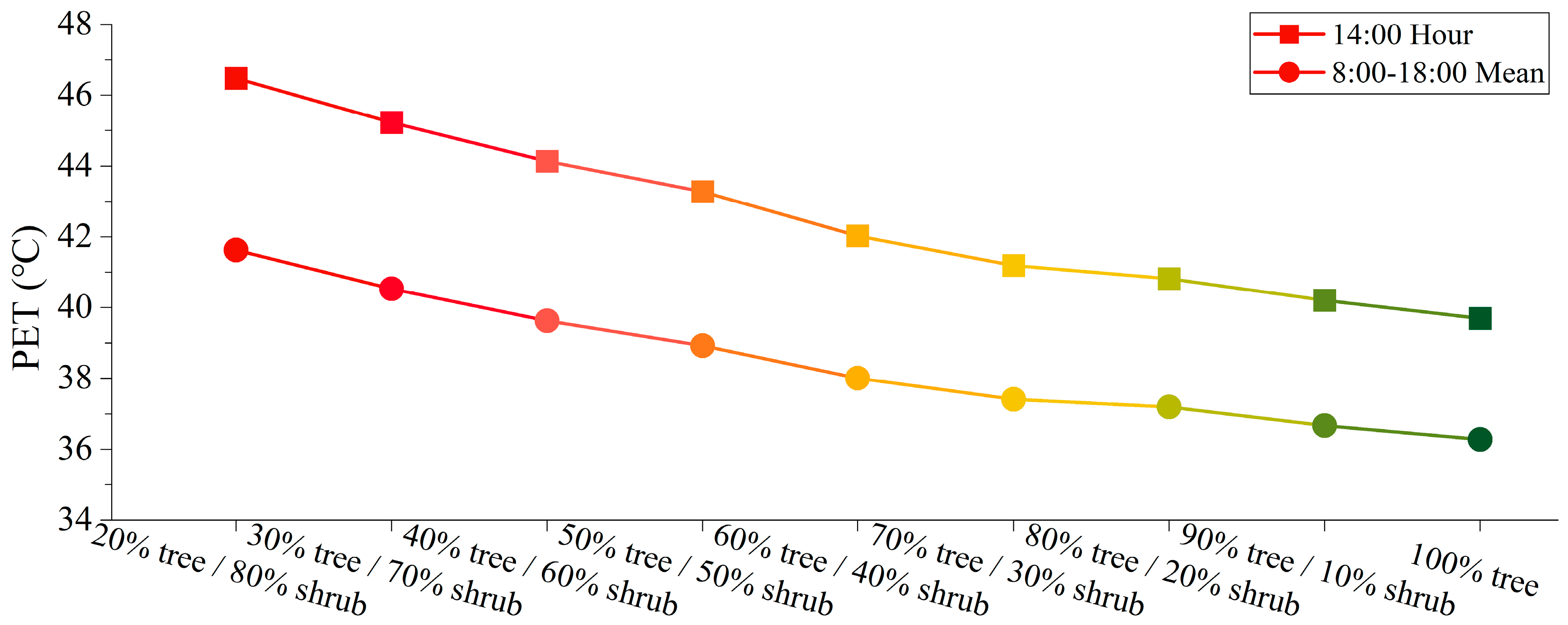
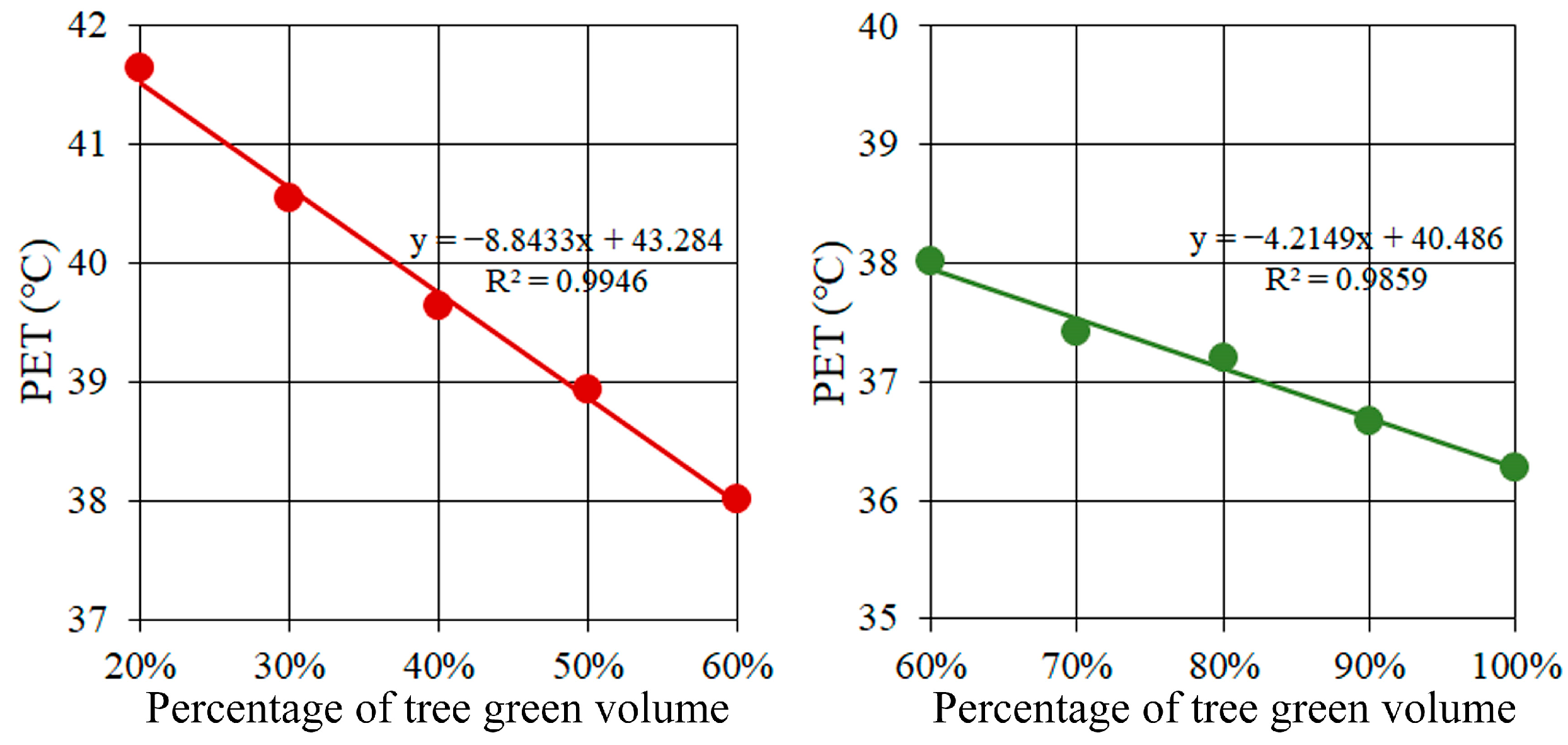
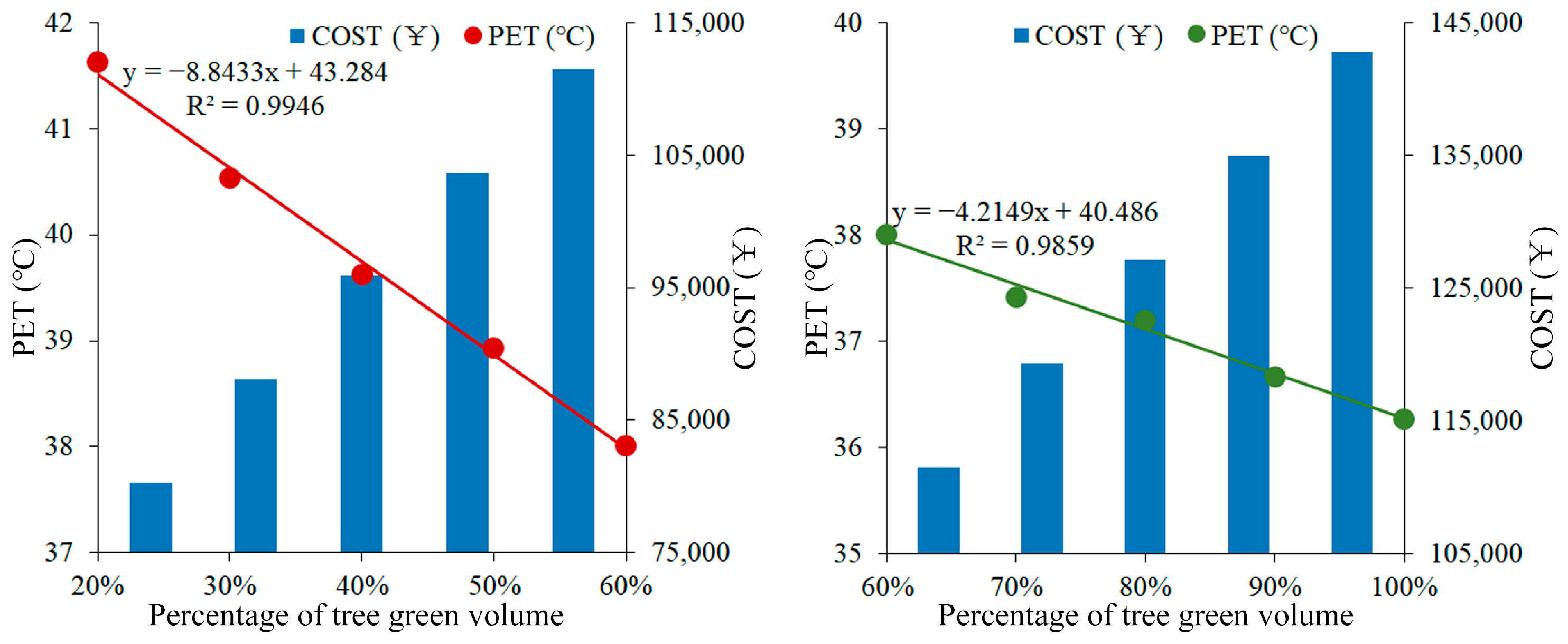
| Plants | Cinnamomum camphora | Pittosporum tobira |
|---|---|---|
| Type | Tree | Shrub |
| LAI | 4.2 | 6.0 |
| Height (m) | 7.0 | 1.3 |
| Crown width (m) | 7.0 | 2.0 |
| Unit cost (¥) | 2380 | 160 |
| PET | Thermal Perception | Physiological Stress Levels |
|---|---|---|
| below 4 °C | Very cold | Extreme cold stress |
| 4 °C to 8 °C | Cold | Intense cold stress |
| 8 °C to 13 °C | Cool | Moderate cold stress |
| 13 °C to 18 °C | Slightly cool | Slight cold stress |
| 18 °C to 23 °C | Cozy | No heat or cold stress |
| 23 °C to 29 °C | Slightly warm | Slight heat stress |
| 29 °C to 35 °C | Warm | Moderate heat stress |
| 35 °C to 41 °C | Hot | Intense heat stress |
| above 41 °C | Very hot | Extreme heat stress |
Disclaimer/Publisher’s Note: The statements, opinions and data contained in all publications are solely those of the individual author(s) and contributor(s) and not of MDPI and/or the editor(s). MDPI and/or the editor(s) disclaim responsibility for any injury to people or property resulting from any ideas, methods, instructions or products referred to in the content. |
© 2024 by the authors. Licensee MDPI, Basel, Switzerland. This article is an open access article distributed under the terms and conditions of the Creative Commons Attribution (CC BY) license (https://creativecommons.org/licenses/by/4.0/).
Share and Cite
Li, Z.; Qi, Z.; Zheng, B.; Luo, X. The Impact of Changes in Green Space Structures on Thermal Mitigation and Costs under a Constant Green Volume. Forests 2024, 15, 1525. https://doi.org/10.3390/f15091525
Li Z, Qi Z, Zheng B, Luo X. The Impact of Changes in Green Space Structures on Thermal Mitigation and Costs under a Constant Green Volume. Forests. 2024; 15(9):1525. https://doi.org/10.3390/f15091525
Chicago/Turabian StyleLi, Zilong, Zhiyong Qi, Bohong Zheng, and Xi Luo. 2024. "The Impact of Changes in Green Space Structures on Thermal Mitigation and Costs under a Constant Green Volume" Forests 15, no. 9: 1525. https://doi.org/10.3390/f15091525





